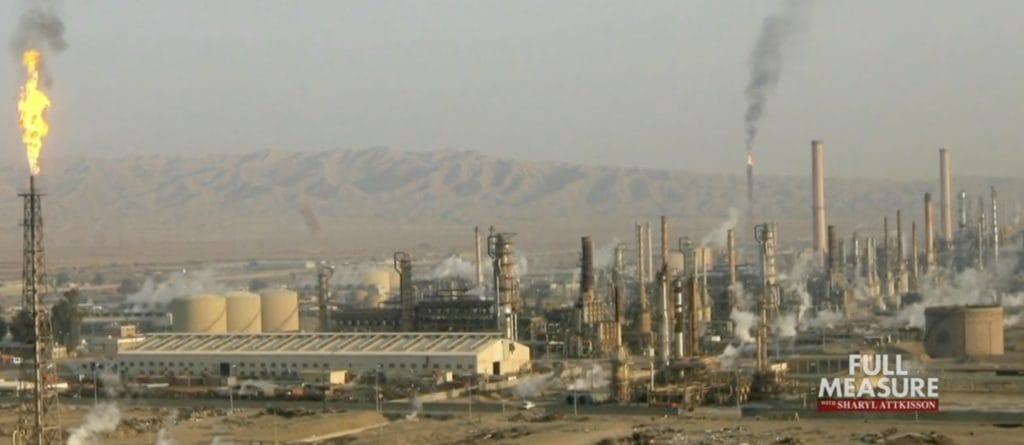(Originally aired Sept. 26, 2021)
Assessments of the human tragedy in Afghanistan after the botched U.S. withdrawal will be coming in for some time. We already know a lot about billions in wasted U.S. tax money from the Inspector General who’s been the chief watchdog on all the spending. Today, under the category of lessons we should have learned, we hear from a senior oil adviser from the Iraq War. He says— too often— successful, low-cost projects haven’t been copied. Gary Vogler is author of: Iraq and the Politics of Oil.
Sharyl: U.S. taxpayers have spent billions upon billions of dollars in the last couple of decades, both in Iraq and Afghanistan on oil related projects and economic projects there.
Gary Vogler: Well, my criticism, you had a show here about Afghanistan, about a $50 million headquarters that a Marine general didn’t want.
FULL MEASURE SIGAR CLIP/2016
Sopko: It was huge: 64,000 approximately square feet.
Nicknamed 64K because of its size, Congress intended it to be headquarters for the 2010 U.S. military surge of 30,000 troops to fight Taliban Islamic extremists.
There was just one problem:
Sopko: The Marine commander, the general on the ground running the surge said ‘I don’t want it, I don’t need it, don’t build it.’ And two other generals above him said the same thing. ‘Don’t build it, we don’t need it. We already have a headquarters. It’s a waste of money.’
But 64K never served as a surge headquarters. In fact, it was still under construction when the surge ended in 2012. Yet U.S. tax dollars continued to pour in for upgrades.
Gary: And I saw something very similar to that in Iraq, where there was a hospital that was constructed out in the middle of someplace and no one used the hospital.
But Vogler says there are examples of relatively inexpensive projects in Iraq that should have served as a model for U.S. Afghan efforts. First, the Baiji Refinery.
Sharyl: What time period was that?
Gary: In early 2007, the Baiji Refinery was in bad shape. It supplied when it was operational, roughly 60% of the country’s gasoline and diesel. ISIS had a strong foothold in the refinery. They controlled what was going on inside the refinery. Even though the refinery manager reported to the Oil Minister in Baghdad, he had a family, and so ISIS threatened his family if he didn’t do what they wanted.
Sharyl: Was ISIS around in 2007?
Gary: Well, it was Al-Qaeda, but it was the early elements of ISIS. They put on a different name tag in 2014, but it was truly the early elements of ISIS.
Vogler says the U.S. helped expel al-Qaeda from of the project and installed capable technical experts.
Gary: In less than one year, the refinery went from about 20% of capacity to 90% of capacity. They were producing more gasoline, more diesel than the North could use. Their production was skyrocketing by the end of 2007, early 2008. They were doing things inside the refinery that they had had not done in years.
Sharyl: How much did a project like that cost?
Gary: The only incremental cost to the US taxpayer was the one technical guy that we sent up there. So for over two or three years, it was less than a million dollars, but that was by far one of the best projects that we undertook.
Vogler says another low cost success story was the Iraq Crude Oil Export Expansion Project to replace and expand a rusting pipeline handling most of Iraq’s oil exports.
Gary: And until we got our project, and we were very concerned because we thought that the pipes would start failing and that the government would of Iraq would not have any income. And so the U.S. taxpayer would have to somehow subsidize the government until we could get this project going. But fortunately it turned out well.
Sharyl: And how much did it cost US taxpayers?
Gary: It cost the U.S. taxpayer $2 million. And with that 2 million, we were able to convince the Iraqis to spend 2 billion of their money, of their oil money. And today it’s delivering probably $10, $20, $30 billion a year to them and will for years to come. So I like to say we spent 2 million to get them to spend 2 billion that will probably get them more than $200 billion in revenue.
Sharyl (on-camera): As for why those kinds of projects aren’t the norm, Vogler says he thinks success came to be measured by how fast the U.S. government could show that it spent enormous sums of money— rather than by the end result.
Watch story here.




Hello Sharyl – I’m looking for the videos you have done highlighting inaccurate news stories. Saw a clip once on TikTok where you highlighted several very inaccurate stories in a row. One after the next. It was affective and I’d like to send to friends who still follow the prescribed narratives.
Hello,
Thank you for your support. I believe you are referring to these links.
https://sharylattkisson.com/2022/06/media-mistakes-in-the-biden-era-the-definitive-list/
What Most people don’t know is there is plenty of oil well’s in Texas and other states Simply Capped off with Plenty of oil in them ..You just need to get them pumping again to bring oil up . “Speed Bump ?